
Tomorrow, Zeb and I will have a perambulation of Conies Down, the forecast is good and the snow has melted. The area is full of archaeology and history with a modicum of mystery. I suppose it might be an idea to check the firing times as some of the area is in the Merrivale range – such an embuggerance. Yes, ’tis ok, they have used all their ammo up during the last couple of days – wonder how much of it we will find?
The etymology of the name is said to derive from an entry in the Minister’s Account of 1352 where it was listed as Condeshull. There is some suggestion the first element stems from the Middle English word Coney which meant a rabbit, so we have hill (hull) of the rabbit (coney). The place-name has given itself not only to the down but to Conies Down tor and a small tributary of the river Cowsic, Conies Down Water. One would have expected that with such a name there may have been an associated rabbit warren but to date there has been no reference. There are three features of note, a Bronze Age stone row, the Lych Path, and the tor.
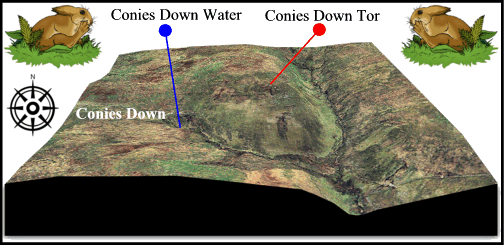
It was -3º C when I drove into the already packed carpark at Omen Beam and that was without the wind-chill factor. That old adage about the cold wind slicing through like a knife came to mind, except this wind had been honed surgically sharp by the granite tors. I was meeting Rose and Sam, some friends whom over the years I have shared many memorable moor days with and who I had not seen for quite a while. I alighted from the car, got lacerated to shreds by the wind, said hello and then returned to the kennel on wheels to clean the dog sick up – yes Zeb was in attendance.
But as the forecast promised a clear blue sky presented itself with bundles of white cloud scudding across it. ‘Twas not long before we were all crunching along the ice coated road towards Black Dunghill. Now there is a name to conjure with, “where have you been today?” “Oh, Black Dunghill.” The mind eye immediately pictures a huge, steaming pile of freshly scraped manure and an old Cockerel crowing from its summit. The only feasible root of this name is that it possibly comes from the Old English word Dunge which means ‘marsh’. Which for anybody who has been there is very apt as the southern flank of the hill is one big ‘marsh’. It was here that it soon became clear that parts of this icy wasteland were not quite as frozen as they would have you believe. A loud splintering crack rang out followed by an oozing, sucking ‘splosh’ as a boot went through the ice and ended up in the deep ‘dunge’.
As we were doing a spot of letterboxing it was decided to have a look for the first box which it transpired was hidden deep in a frozen, snow covered peat bank. Sadly we had not brought a stick of dynamite or a JCB with us so the elusive box had to stay in its icy tomb of snow and frozen peat. But as we were attempting to scrape away the snow another loud splintering crack rang out, this time it was followed by the sound of what only could be described as ‘Saturday afternoon at the swimming baths’. Zeb had gone through the ice and ended up submerged in a huge pool of icy water After he finally extracted himself the look of astonishment on his face was classic, it said “cor, what the hell was that?”
From the ‘Black Hill of the Dunge’ we crunched and cracked our way through the scattered snowdrifts towards the timeless Lych Path or ‘Way of the Dead’. This old trans-moor track has seen the weary trudge of travellers for hundreds of years and has resulted in a hollow way which today was highlighted by a carpet of snow, as can be seen from the photo below:
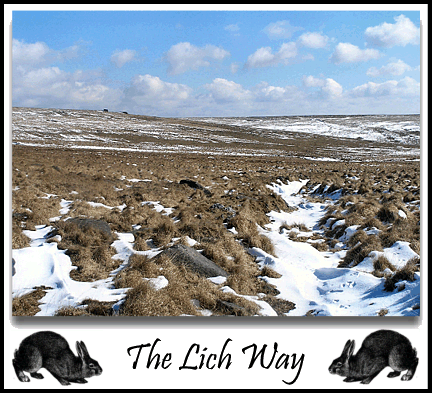 You can see the old track winding up from the right with Conies Down tor on the far horizon. Not surprisingly there are a few letterboxes sited within the area which commemorate the history of the Lych Way, shame about Connies Down tor?
You can see the old track winding up from the right with Conies Down tor on the far horizon. Not surprisingly there are a few letterboxes sited within the area which commemorate the history of the Lych Way, shame about Connies Down tor?
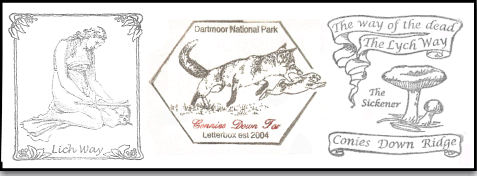
It was well we were searching for a few of them that the contents of the myriad of mini buses parked at Omen Beam appeared on the far horizon. Today was a training day for the forthcoming ‘Ten Tors Expedition‘ and the hoards of youngsters were getting a possible taster of what awaits them.
The next port of call was the stone row which sits on the southern side of Conies Down. This Bronze Age relic cannot be said to be one of the better examples of a stone row as many of the stones have either sunk into the peat or have been removed for other purposes. In fact there are several guide stones in the sunken holloway of the Lych Way which look as if they originated from the row. This is a double stone row and it is estimated to have been roughly 188 yards (172m) long and according to Hemery is the highest placed stone row on Dartmoor.
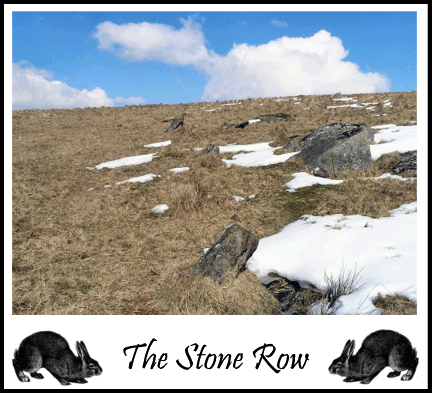
It was then only a short stroll up to the two outcrops which make up Conies Down tor which it must be said is not the most impressive rock pile on Dartmoor. But the lack of size or shape is by easily compensated for by the splendid views from its summit. Across the Cowsic Valley to the north-west stands the Beardown Man standing stone, silently surveying the lands of its builders. This is one of the remotest of Dartmoor’s menhirs and one could say the most enigmatic of its kind.
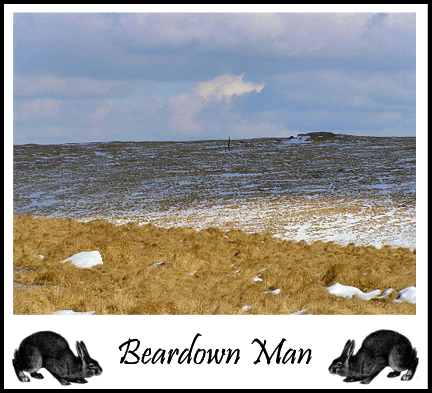 The view to the south drinks in the wide lower valley of the river Cowsic and today it looked stunning. The best things in life are free and you won’t get a better bargain than this.
The view to the south drinks in the wide lower valley of the river Cowsic and today it looked stunning. The best things in life are free and you won’t get a better bargain than this.
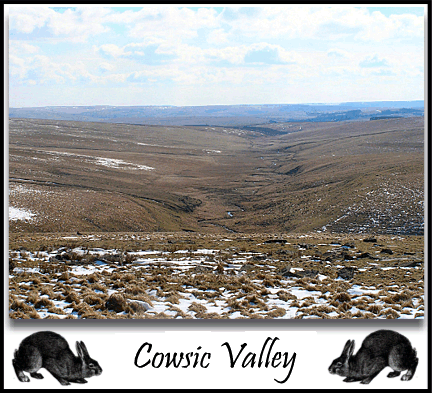
By now the lunch hand of the clock had reached a sandwich to coffee and I presume the fact that Zeb had spent the last hour devouring every bone he could find meant he was hungry too. Not surprising I suppose as the last meal he had was the previous night’s dinner, I work on the theory that the less he eats before getting in the car the less I have to mop up. If one wished for a quiet spot for lunch this was not it, all the intrepid Ten Tors youngsters obviously wanted some sustanance and chose Conies tor for the ideal spot. Luckily we laid claim to the only sheltered leeward spot as no sooner had the lunch boxes come out than it began to snow. Nothing startling, just that dry, hard, languid snow that bounces off your nose type which the relaxed conversation of old times soon melted away. Suddenly we were ten years younger as we reminisced on days spent down the old tin mines, evenings down the old inns and the many ‘wind-ups’ played on fellow walkers. The talk soon got around to people no longer with us and of those who have begun to suffer the ravages of time. It was slightly alarming to see how one, in later life, pays the penalty for endless days spent tramping the wilds of Dartmoor. The wild moorland weather not only erodes the granite tors it eats away at human joints, numerous hardened moor walkers were mentioned all with bad backs, knee problems, and shoulder pains. Having spent a delightful spell in the ‘good old days’ we were brought groaning back to the present as stiff joints cracked and clicked in order to let us stand up. Is this a habit of aging? I have noticed that over the past few years I automatically give out a groan whenever I stand up. But most times, when you think why you groaned there is no reason, nothing hurts, there is no pain it just seems the right thing to do?
It was now time to start to head back but not after dropping down to the small feeder stream which tumbles eagerly towards the Cowsic – this is Conies Down Water. Today the sides of the stream are studded with pockets of snow and overhanging frozen fronds of grass. There is evidence that the old tinners have been at work in efforts to wrest the precious ore from the banks and waters. The dog attempts to drink the stream dry, must have been all those skeletons he had chomped his way through.
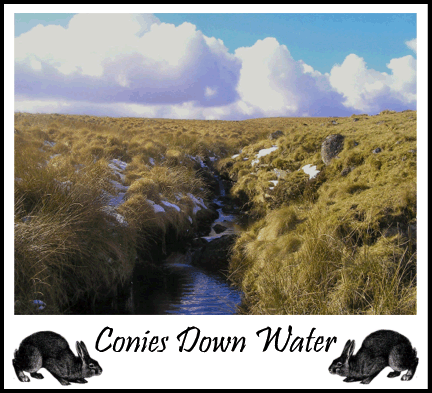
Climbing up the hillside you come to the large, lone boulder that was once the home to a small brass cross. This rock sits just above Traveller’s Ford which is where the old Lych Way crosses the river Cowsic. From here there is a good view of the two outcrops which make Conies Down tor. The left-hand pile always reminds me of a battle tank, the eroded tip being the turret.
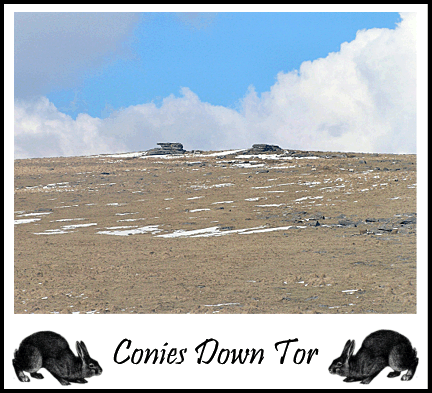
By now Zeb was in disgrace and on the lead because he had enthusiastically introduced himself to a sheep. I must admit that he was only being his usual friendly self but the poor sheep was not to know that. Sadly this now means he will spend the rest of his Dartmoor days on the lead, that is unless I can find a particularly aggressive ram to introduce him to. I remember on my uncle’s farm, he always used to put a new pup in a pen with the ram – from that moment on they would always work the sheep but never chase them – respect I think is the word. On the way back I was once again rewarded with finding something I needed a photograph of, Dartmoor Matchsticks. Sounds sad but I want to do a page on these little lichens that are one of my favourites. Not far from these was the evidence of the military use of the moor in the form of the rusted fin of a mortar shell sticking up out of the peat. Self preservation dictated that no further investigation was needed, another sign of aging as there would have been a time when it would have been excavated and placed in the ‘Dartmoor Collection’.
By the time we reached the car park it was like a scene from Klosters, snowmen, snow balls, and snow boards. I suppose one must not be selfish as a national park is meant to be home to a diversity of pleasures and pursuits but …
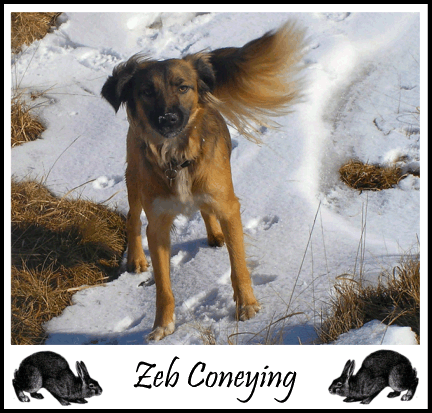

9.00 pm after the walk – butter wouldn’t melt?
 Legendary Dartmoor The many aspects past and present of Dartmoor
Legendary Dartmoor The many aspects past and present of Dartmoor
